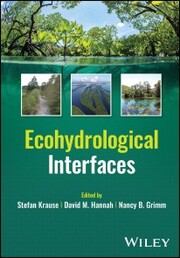<b>Ecohydrological Interfaces</b><p><b>Comprehensive overview of the process dynamics and interactions governing ecohydrological interfaces</b><p>Summarizing the interdisciplinary investigation of ecohydrological interface functioning,<i>Ecohydrological Interfaces</i> advances the understanding of their dynamics across traditional subject boundaries. It offers a detailed explanation of the underlying mechanisms and process interactions governing ecohydrological interface functioning from the micro scale to the ecosystem and regional scale.<p>The multidisciplinary team of authors integrates and synthesises the current understanding of process dynamics at different ecohydrological interfaces to develop a unifying concept of their ecosystem functions. The work introduces novel experimental and model-based methods for characterizing and quantifying ecohydrological interface processes, taking account of innovative sensing and tracing technologies as well as microbial and molecular biology approaches.<p>Key questions addressed in the book include:<ul><li>Which conditions stimulate the transformative nature of ecohydrological interfaces?</li><li>How are ecohydrological interfaces organized in space and time?</li><li>How does interface activity propagate from small to large scales?</li><li>How do ecohydrological interfaces react to environmental change and what is their role in processes of significant societal value?</li></ul><p>As a research level text on the functionality and performance of ecohydrological interfaces,<i>Ecohydrological Interfaces</i> is primarily aimed at academics and postgraduate researchers. It is also appropriate for university libraries as further reading on a range of geographical, environmental, biological, and engineering topics.
Stefan Krause, School of Geography, Earth and Environmental Science, University of Birmingham, UK and LEHNA Laboratoire dEcologie des Hydrosystèmes Naturels et Anthropisés, Universitè Claude Bernard Lyon 1, France.David M. Hannah, School of Geography, Earth and Environmental Science, University of Birmingham, UK.Nancy B. Grimm, School of Life Sciences, Arizona State University, Tempe, USA.
Preface viiList of Contributors ixSection 1 11 Ecohydrological Interfaces as Hotspots of Ecosystem Processes 3Stefan Krause, Jörg Lewandowski, Nancy B. Grimm, David M. Hannah, Gilles Pinay, Karlie McDonald, Eugènia Martí, Alba Argerich, Laurent Pfister, Julian Klaus, Tom Battin, Scott T. Larned, Jacob Schelker, Jan Fleckenstein, Christian Schmidt, Michael O Rivett, Glenn Watts, Francesc Sabater, Albert Sorolla, and Valentina Turk2 Biological Activity as a Trigger of Enhanced Ecohydrological Interface Activity 29Julian Klaus, Viktor Baranov, Jörg Lewandowski, Anne Zangerlé, and Loes van SchaikSection 2 413 The Four Interfaces Components of Riparian Zones 43Gilles Pinay, S. Bernal, Jake Diamond, Hanieh Sayedhashemi, Benjamin Abbott, and Florentina Moatar4 Organizational Principles of Hyporheic Exchange Flow and Biogeochemical Cycling in River Networks across Scales 63Stefan Krause, Benjamin W. Abbott, Viktor Baranov, Susana Bernal, Phillip Blaen, Thibault Datry, Jennifer Drummond, Jan H. Fleckenstein, Jesus Gomez Velez, David M. Hannah, Julia L. A. Knapp, Marie Kurz, Jörg Lewandowski, Eugènia Martí, Clara Mendoza-Lera, Alexander Milner, Aaron Packman, Gilles Pinay, Adam S. Ward, and Jay P. Zarnetzke5 GroundwaterLake Interfaces 103Jörg Lewandowski, Donald O. Rosenberry, and Karin Meinikmann6 CoastalGroundwater Interfaces (Submarine Groundwater Discharge) 123Michael E. Böttcher, Ulf Mallast, Gudrun Massmann, Nils Moosdorf, Mike Müller-Petke, and Hannelore WaskaSection 3 1497 Identifying and Quantifying Water Fluxes at Ecohydrological Interfaces 151Christian Schmidt and Jan Fleckenstein 1518 Heat as a Hydrological Tracer 167Christian Schmidt, Jörg Lewandowski, J. N. Galloway, Athena Chalari, Francesco Ciocca, Stefan Krause, Laurant Pfister, and M. Antonelli9 Sampling at GroundwaterSurface Water Interfaces 191Jörg Lewandowski, Jonas Schaper, Michael Rivett, and Stefan Krause10 Automated Sensing Methods for Dissolved Organic Matter and Inorganic Nutrient Monitoring in Freshwater Systems 213Phillip J. Blaen, Kieran Khamis, Charlotte E.M. Lloyd, Chris Bradley, David Hannah, and Stefan Krause11 Tracing Hydrological Connectivity with Aerial Diatoms 235L. Pfister, J. Klaus, C.E. Wetzel, M. Antonelli, and N. Martínez-Carreras12 Measurement of Metabolic Rates at the SedimentWater Interface Using Experimental Ecosystems 245Alba Argerich and Janine Rüegg13 Using Diel Solute Signals to Assess Ecohydrological Processing in Lotic Systems 265Marie J. Kurz and Julia L.A. Knapp14 Evolving Molecular Methodologies for Monitoring Pathogenic Viruses in Ecohydrological Interfaces 297Katarina Kova, Mukundh N. Balasubramanian, Matja? Hren, Ion Gutierrez Aguirre, and Valentina TurkSection 4 33115 Global Environmental Pressures 333Glenn Watts 33316 Restoring the Liver of the River: Actionable Research Insights to Guide the Restoration of the Hyporheic Zone for the Improvement of Water Quality 355Ben Christopher Howard, Ian Baker, Mike Blackmore, Nicholas Kettridge, Sami Ullah, and Stefan KrauseIndex 391
„E-Book“ steht für digitales Buch. Um diese Art von Büchern lesen zu können wird entweder eine spezielle Software für Computer, Tablets und Smartphones oder ein E-Book Reader benötigt. Da viele verschiedene Formate (Dateien) für E-Books existieren, gilt es dabei, einiges zu beachten.
Von uns werden digitale Bücher in drei Formaten ausgeliefert. Die Formate sind EPUB mit DRM (Digital Rights Management), EPUB ohne DRM und PDF. Bei den Formaten PDF und EPUB ohne DRM müssen Sie lediglich prüfen, ob Ihr E-Book Reader kompatibel ist. Wenn ein Format mit DRM genutzt wird, besteht zusätzlich die Notwendigkeit, dass Sie einen kostenlosen Adobe® Digital Editions Account besitzen. Wenn Sie ein E-Book, das Adobe® Digital Editions benötigt herunterladen, erhalten Sie eine ASCM-Datei, die zu Digital Editions hinzugefügt und mit Ihrem Account verknüpft werden muss. Einige E-Book Reader (zum Beispiel PocketBook Touch) unterstützen auch das direkte Eingeben der Login-Daten des Adobe Accounts – somit können diese ASCM-Dateien direkt auf das betreffende Gerät kopiert werden.
Da E-Books nur für eine begrenzte Zeit – in der Regel 6 Monate – herunterladbar sind, sollten Sie stets eine Sicherheitskopie auf einem Dauerspeicher (Festplatte, USB-Stick oder CD) vorsehen. Auch ist die Menge der Downloads auf maximal 5 begrenzt.






